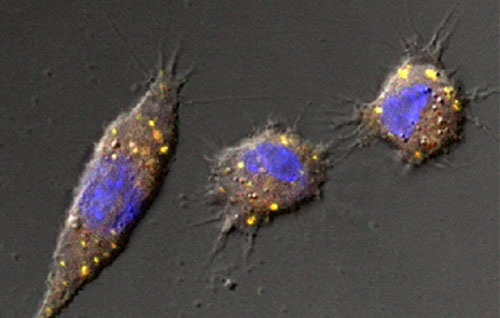Nanoparticles and human health

Confocal microscopy image of macrophages taking up SiO2 nanoparticles (yellow) in endosomes
Immunosafety of nanoparticles is an area of special interest. The immune system professionally recognizes non-self entities and categorises them into harmless ones which are tolerated, or dangerous ones against which defence is initiated. Nanoparticles overlap in size range with viruses and immune cells can recognize them well. It has been shown that specific immune receptors can be activated by some nanoparticles, which links them directly to key immune decisions.
Immunotoxicity may be due to killing of immune cells, or to stimulatory or suppressive signals derived from nanoparticles. Indirect effects can occur, e.g. when toxic ions are released or when reactive oxygen species are produced at the surface of metal nanoparticles. Small effects are usually harmless and homeostasis is quickly regained. On the other hand, stronger effects may be detrimental to health, in particular for high-risk persons (very young or old age, existing disease, pregnancy, genetic background) and upon chronic or repeated exposure. Immune responses associated with inflammation and with cellular stress provide important markers that sense potential danger before obvious toxicity becomes apparent by death of cells or organisms.
Confirmed and reproducible effects on the immune system are interesting, considering that both immune activation and immune suppression have applications in medicine, and indeed, nanomedicine is a quickly developing field. Usually, however, it is desired that the immune system should tolerate nanoparticles. This is the most frequently observed outcome, which is facilitated by the fact that nanoparticles are upon contact with the body nearly immediately coated by biological agents, mostly by proteins. Nevertheless, there are cases where nanoparticles elicit detrimental responses and it is at present not well understood which properties of nanoparticles makes them toxic (like size, shape, material, coating, surface area, surface charge). Similarly, we do not sufficiently understand which molecular mechanisms, receptors and signalling pathways are responsible for mediating detrimental interactions. Interactions with the allergic branch of immunity have so far barely been studied. Understanding the induction (or suppression) of inflammatory or allergic responses towards nanoparticles sheds light on decisions and mis-decisions of the immune system in general.
We are working towards a better understanding of nano/bio-interactions, supported by previous work from already finished European projects (FP5 MAAPHRI, FP6 NoMiracle, FP6 DIPNA) and by presently ongoing ones (FP7 NanoTOES, FP7 NanoValid). An interdisciplinary topic like nanosafety requires input from many different fields and we are fortunate to cooperate closely with many excellent European labs in our projects about nanosafety.
More information on the ongoing projects is available on the Projects page of this website. General information on nanosafety – to which we are also contributing – can be found at nanoobjects.info.




